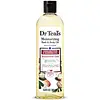What's inside
What's inside
 Key Ingredients
Key Ingredients

 Benefits
Benefits

 Concerns
Concerns

 Ingredients Side-by-side
Ingredients Side-by-side

Carthamus Tinctorius Seed Oil
MaskingIsododecane
EmollientCaprylic/Capric Triglyceride
MaskingIsopropyl Myristate
EmollientParfum
MaskingOryza Sativa Bran Extract
Skin ConditioningBenzyl Alcohol
PerfumingHelianthus Annuus Extract
EmollientPrunus Armeniaca Kernel Oil
MaskingArgania Spinosa Kernel Oil
EmollientRosmarinus Officinalis Leaf Extract
AntimicrobialTocopherol
AntioxidantPelargonium Graveolens Flower Oil
MaskingButyrospermum Parkii Butter
Skin ConditioningLimonene
PerfumingCoumarin
PerfumingBenzyl Benzoate
AntimicrobialCitronellol
PerfumingGeraniol
PerfumingTheobroma Grandiflorum Seed Butter
Skin ConditioningPistacia Vera Seed Oil
Skin ConditioningLinalool
PerfumingCitral
PerfumingPaullinia Cupana Seed Extract
Skin ConditioningCarthamus Tinctorius Seed Oil, Isododecane, Caprylic/Capric Triglyceride, Isopropyl Myristate, Parfum, Oryza Sativa Bran Extract, Benzyl Alcohol, Helianthus Annuus Extract, Prunus Armeniaca Kernel Oil, Argania Spinosa Kernel Oil, Rosmarinus Officinalis Leaf Extract, Tocopherol, Pelargonium Graveolens Flower Oil, Butyrospermum Parkii Butter, Limonene, Coumarin, Benzyl Benzoate, Citronellol, Geraniol, Theobroma Grandiflorum Seed Butter, Pistacia Vera Seed Oil, Linalool, Citral, Paullinia Cupana Seed Extract
Glycine Soja Oil
EmollientSesamum Indicum Seed Oil
EmollientParfum
MaskingPrunus Amygdalus Dulcis Oil
Skin ConditioningAmyris Balsamifera Bark Oil
MaskingCanola Oil
EmollientButyrospermum Parkii Butter
Skin ConditioningCarthamus Tinctorius Seed Oil
MaskingRicinus Communis Seed Oil
MaskingTheobroma Cacao Seed Butter
EmollientSimmondsia Chinensis Seed Oil
EmollientVitis Vinifera Seed Oil
EmollientAloe Barbadensis Leaf Extract
EmollientTocopheryl Acetate
AntioxidantMagnesium Sulfate
Cyclopentasiloxane
EmollientBHT
AntioxidantPhenyl Trimethicone
Skin ConditioningCI 61565
Cosmetic ColorantGlycine Soja Oil, Sesamum Indicum Seed Oil, Parfum, Prunus Amygdalus Dulcis Oil, Amyris Balsamifera Bark Oil, Canola Oil, Butyrospermum Parkii Butter, Carthamus Tinctorius Seed Oil, Ricinus Communis Seed Oil, Theobroma Cacao Seed Butter, Simmondsia Chinensis Seed Oil, Vitis Vinifera Seed Oil, Aloe Barbadensis Leaf Extract, Tocopheryl Acetate, Magnesium Sulfate, Cyclopentasiloxane, BHT, Phenyl Trimethicone, CI 61565
Ingredients Explained
These ingredients are found in both products.
Ingredients higher up in an ingredient list are typically present in a larger amount.
This ingredient is also known as shea butter. It is an effective skin hydrator and emollient.
Emollients help soothe and soften your skin. It does this by creating a protective film on your skin. This barrier helps trap moisture and keeps your skin hydrated. Emollients may be effective at treating dry or itchy skin.
Shea butter is rich in antioxidants. Antioxidants help fight free-radicals, or molecules that may harm the body. It is also full of fatty acids including stearic acid and linoleic acid. These acids help replenish the skin and keep skin moisturized.
While Shea Butter has an SPF rating of about 3-4, it is not a sunscreen replacement.
Shea butter may not be fungal acne safe. We recommend speaking with a professional if you have any concerns.
Learn more about Butyrospermum Parkii ButterCarthamus tinctorius seed oil comes from safflower, one of humanity's oldest crops.
Safflower seed oil contains a high percentage of linoleic acid and oleic acid. It also contains Vitamin E. These three components are effective moisturizers.
Vitamin E helps nourish your skin's lipid barrier. It is also a potent antioxidant. Antioxidants help fight free-radical molecules, or unstable molecules that may damage your skin cells.
Due to its high fatty acid content, this ingredient may not be malassezia folliculitis safe.
Thoughout history, safflower has been used for dying fabrics and in food as a saffron substitute.
Learn more about Carthamus Tinctorius Seed OilParfum is a catch-all term for an ingredient or more that is used to give a scent to products.
Also called "fragrance", this ingredient can be a blend of hundreds of chemicals or plant oils. This means every product with "fragrance" or "parfum" in the ingredients list is a different mixture.
For instance, Habanolide is a proprietary trade name for a specific aroma chemical. When used as a fragrance ingredient in cosmetics, most aroma chemicals fall under the broad labeling category of “FRAGRANCE” or “PARFUM” according to EU and US regulations.
The term 'parfum' or 'fragrance' is not regulated in many countries. In many cases, it is up to the brand to define this term.
For instance, many brands choose to label themselves as "fragrance-free" because they are not using synthetic fragrances. However, their products may still contain ingredients such as essential oils that are considered a fragrance by INCI standards.
One example is Calendula flower extract. Calendula is an essential oil that still imparts a scent or 'fragrance'.
Depending on the blend, the ingredients in the mixture can cause allergies and sensitivities on the skin. Some ingredients that are known EU allergens include linalool and citronellol.
Parfum can also be used to mask or cover an unpleasant scent.
The bottom line is: not all fragrances/parfum/ingredients are created equally. If you are worried about fragrances, we recommend taking a closer look at an ingredient. And of course, we always recommend speaking with a professional.
Learn more about Parfum